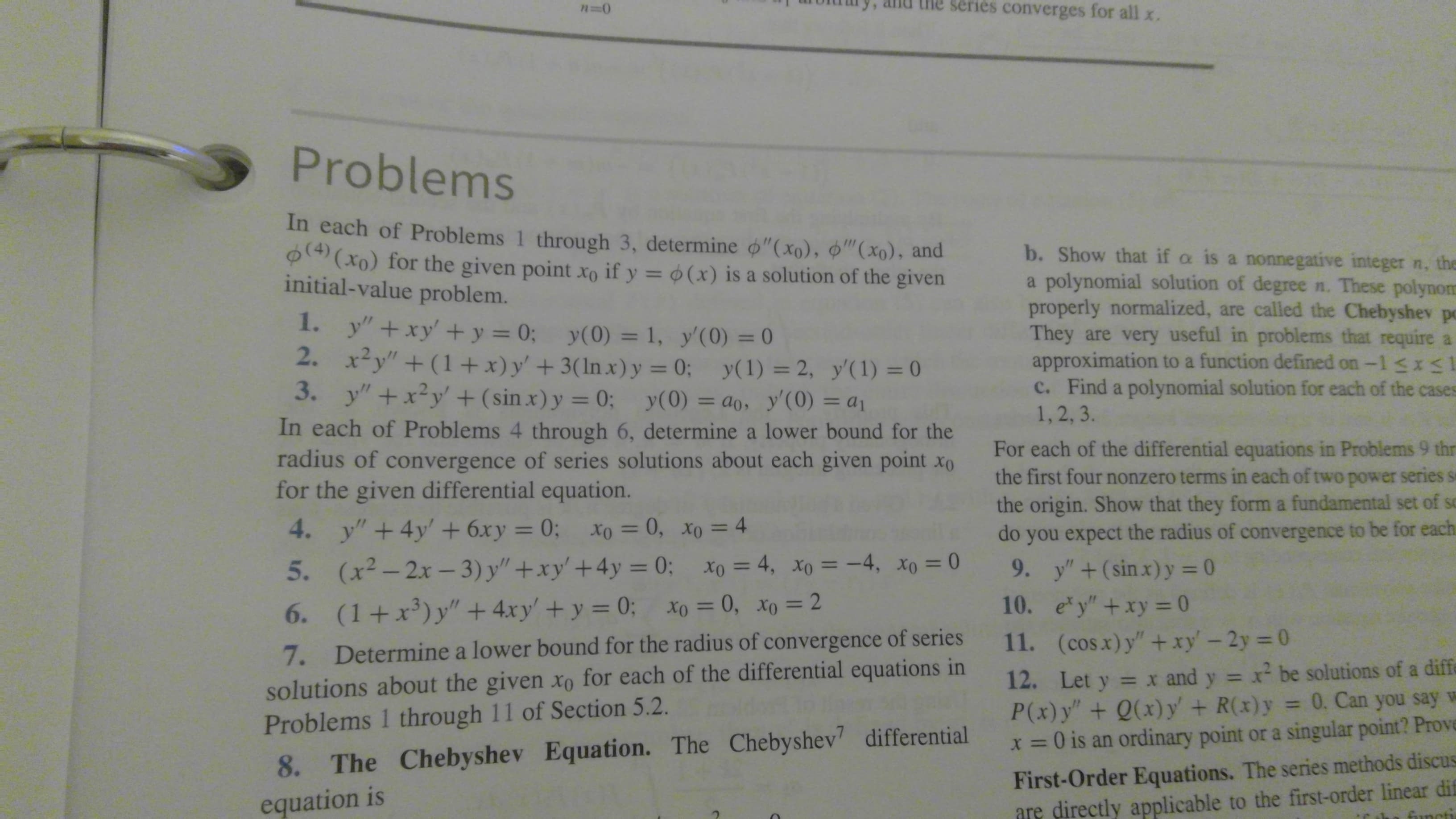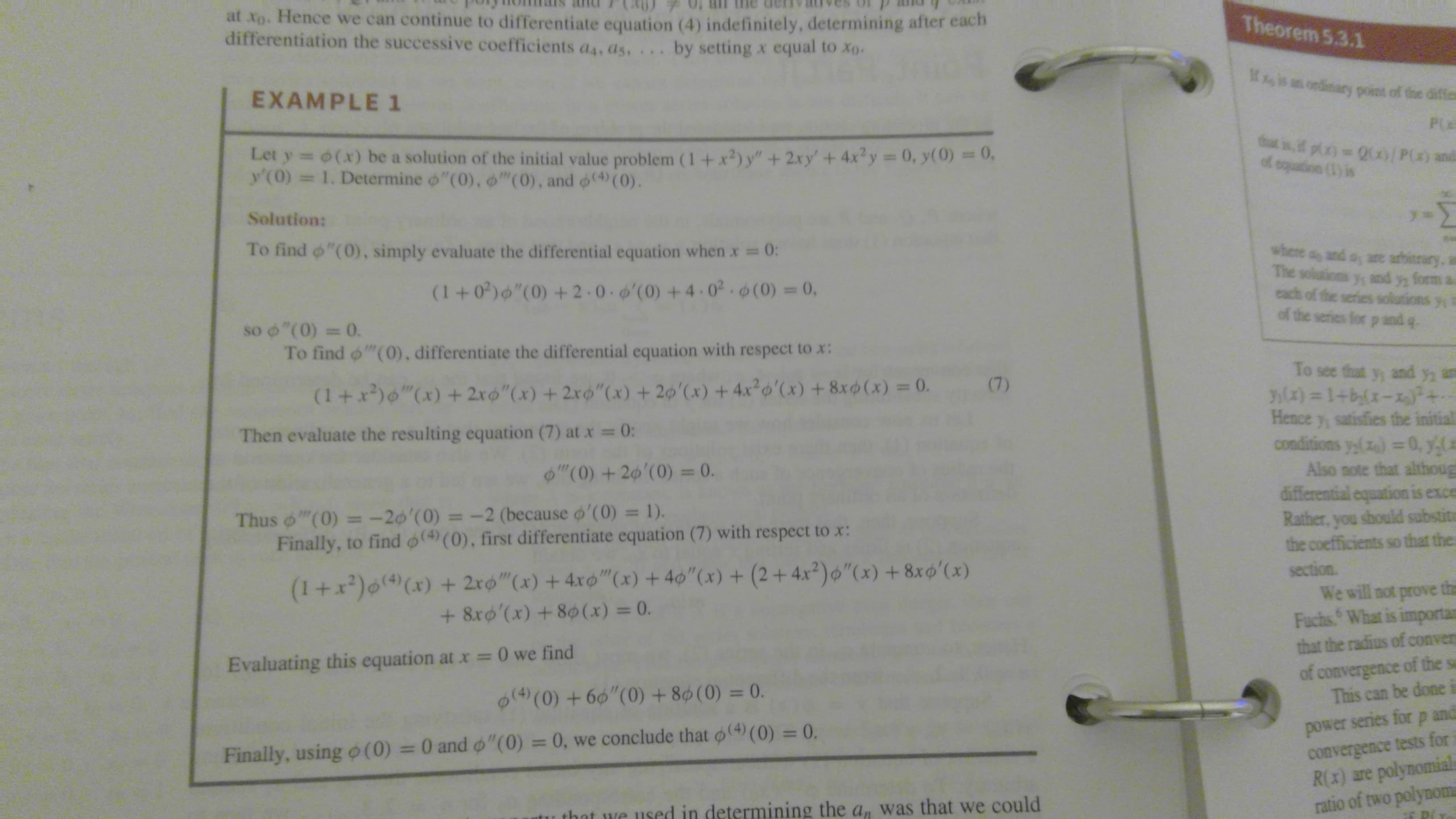series converges for all x. Problems In each of Problems 1 through 3, determine o"(xo), Q"(xo), and 0 (x0) for the given point xo if y = 0(x) is a solution of the given initial-value problem. b. Show that if a is a nonnegative integer n, the a polynomial solution of degree n. These polynom properly normalized, are called the Chebyshev po They are very useful in problems that require a approximation to a function defined on-1
series converges for all x. Problems In each of Problems 1 through 3, determine o"(xo), Q"(xo), and 0 (x0) for the given point xo if y = 0(x) is a solution of the given initial-value problem. b. Show that if a is a nonnegative integer n, the a polynomial solution of degree n. These polynom properly normalized, are called the Chebyshev po They are very useful in problems that require a approximation to a function defined on-1
Algebra & Trigonometry with Analytic Geometry
13th Edition
ISBN:9781133382119
Author:Swokowski
Publisher:Swokowski
Chapter5: Inverse, Exponential, And Logarithmic Functions
Section5.6: Exponential And Logarithmic Equations
Problem 64E
Related questions
Question
How do I appropriately answer Problem #3 from my Differential Equations Textbook? This specific problem is from a section titled, "Series Solutions Near an Ordinary Point, Part II. I'm guessing that what I would need to do is use some type of Power Series that makes me get a's, and then try to determine the initial values. Although, I'm not quite sure. It wouldn't surprise me if that were the case because I have been doing such ways for a while. Except for any type of initial values.

Transcribed Image Text:series converges for all x.
Problems
In each of Problems 1 through 3, determine o"(xo), Q"(xo), and
0 (x0) for the given point xo if y = 0(x) is a solution of the given
initial-value problem.
b. Show that if a is a nonnegative integer n, the
a polynomial solution of degree n. These polynom
properly normalized, are called the Chebyshev po
They are very useful in problems that require a
approximation to a function defined on-1 <xS1
c. Find a polynomial solution for each of the cases
1,2, 3.
%3D
1. y" +xy' +y = 0; y(0) = 1, y'(0) = 0
2. x2y"+ (1+ x) y' +3(ln x) y = 0; y(1) = 2, y'(1) = 0
3. y"+x²y' +(sin x)y = 0; y(0) = ao, y'(0) = a1
%3D
%3D
%3D
%3D
%3D
%3D
In each of Problems 4 through 6, determine a lower bound for the
radius of convergence of series solutions about each given point xo
for the given differential equation.
For each of the differential equations in Problems 9 thr
the first four nonzero terms in each of two power series s
the origin. Show that they form a fundamental set of so
y"+4y' + 6xy = 0;
xo = 0, x0 = 4
4.
%3D
%3D
do you expect the radius of convergence to be for each
%3D
5. (x2-2x-3) y"+xy'+4y = 0;
6. (1+x)y" + 4xy' +y = 03;
Xo = 4, xo = -4, xo =0
y"+(sin x)y = 0
ey"+xy = 0
9.
%3D
%3D
%3D
Xo = 0, xo = 2
10.
%3D
%3D
7. Determine a lower bound for the radius of convergence of series
solutions about the given xo for each of the differential equations in
Problems 1 through 11 of Section 5.2.
11. (cosx)y"+xy'-2y 0
12. Let y = x and y = x be solutions of a diffe
P(x)y" + Q(x)y' + R(x)y = 0. Can you say
x =0 is an ordinary point or a singular point? Prove
%3D
%3D
%3D
8. The Chebyshev Equation. The Chebyshev differential
First-Order Equations. The series methods discus
are directly applicable to the first-order linear dif
functi
equation is

Transcribed Image Text:at Xo. Hence we can continue to differentiate equation (4) indefinitely, determining after each
differentiation the successive coefficients as, ds, by setting x equal to Xo-
Theorem 5.3.1
M is an ondinary point of the differ
EXAMPLE 1
PCe
tht is, if px)Q00 P0) and
of equation (1) is
Let y
y'(0)
o(x) be a solution of the initial value problem (1+x?) y" + 2xy' + 4x2y
1. Determine o"(0), o"(0), and o(4)(0).
0, y(0)= 0,
%3D
Solution:
where a and a are arbitrary. c
The solutions y, and y form a
each of the seria
of the series for p and q.
To find o"(0), simply evaluate the differential equation when x
0:
(1+0)o"(0) +2.0.6(0) +4 02 0(0) 0,
ons y
so o"(0) = 0.
To find o"(0), differentiate the differential equation with respect to x:
To see that y, and y, am
()%3D1+b(x-x)
Hence y, satisfies the initial
conditions yy(x) =0, y(
Also note that althoug
differential equation is exce
Rather, you should substits
the coefficients so that the
(7)
(1+x)0"(x) + 2xo"(x) + 2xo"(x) + 20'(x) + 4.x²o'(x) + 8xo(x) = 0.
Then evaluate the resulting equation (7) at x=0:
%3D
O"(0) +20'(0) = 0.
%3D
Thus o"(0) =-20'(0) =-2 (because o'(0) = 1).
Finally, to findo(0), first differentiate equation (7) with respect to x:
%3D
section.
We will not prove the
Fuchs What is importan
that the radius of convers
(1+x²)6((x) + 2ro"(x) + 4xo"(x) + 40"(x) + (2 + 4x²)o"(x) + 8xo'(x)
+ 8xo (x) + 80(x) = 0.
%3D
of convergence of the sa
This can be donei
%3D
Evaluating this equation at x =0 we find
((0) +66"(0) + 80 (0) = 0.
power series for p and
convergence tests for
R(x) are polynomials
ratio of two polynoma
%3D
%3D
%3D
Finally, using 0(0) = 0 and o"(0) = 0, we conclude that o( (0) = 0.
tu that we used in determining the a, was that we could
Expert Solution
This question has been solved!
Explore an expertly crafted, step-by-step solution for a thorough understanding of key concepts.
This is a popular solution!
Trending now
This is a popular solution!
Step by step
Solved in 5 steps with 5 images

Knowledge Booster
Learn more about
Need a deep-dive on the concept behind this application? Look no further. Learn more about this topic, advanced-math and related others by exploring similar questions and additional content below.Recommended textbooks for you

Algebra & Trigonometry with Analytic Geometry
Algebra
ISBN:
9781133382119
Author:
Swokowski
Publisher:
Cengage

Algebra & Trigonometry with Analytic Geometry
Algebra
ISBN:
9781133382119
Author:
Swokowski
Publisher:
Cengage